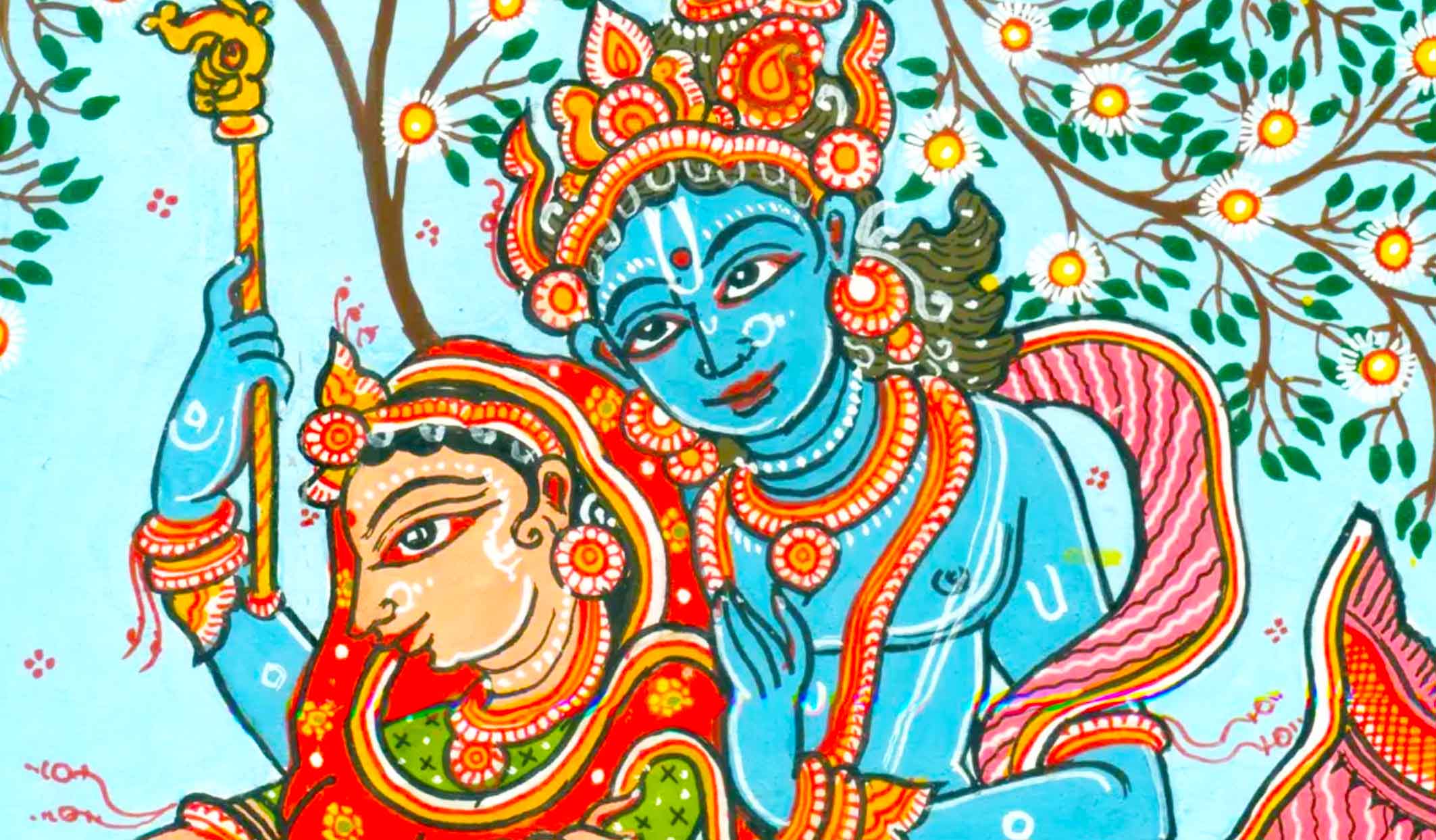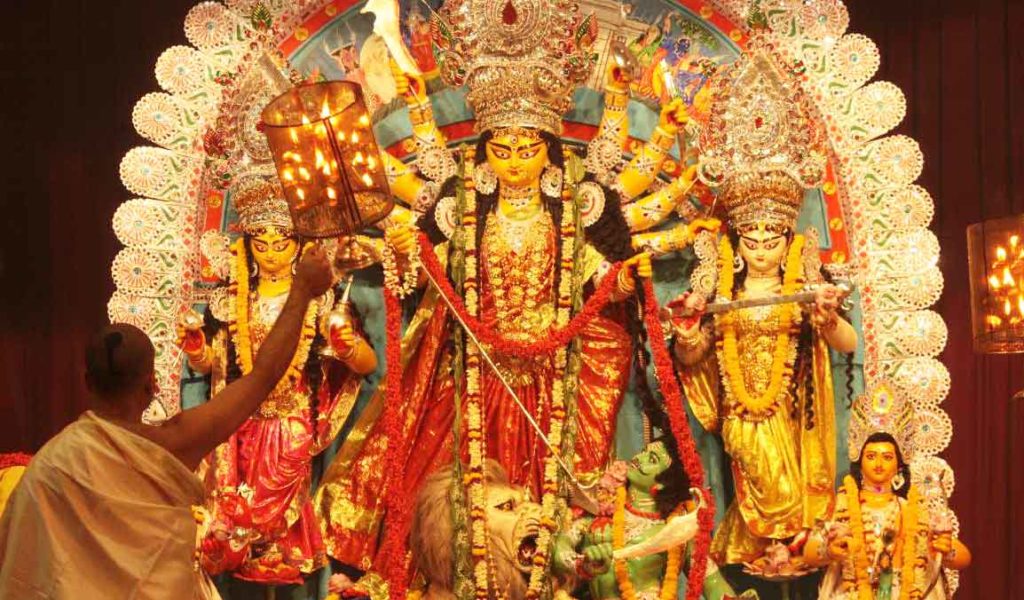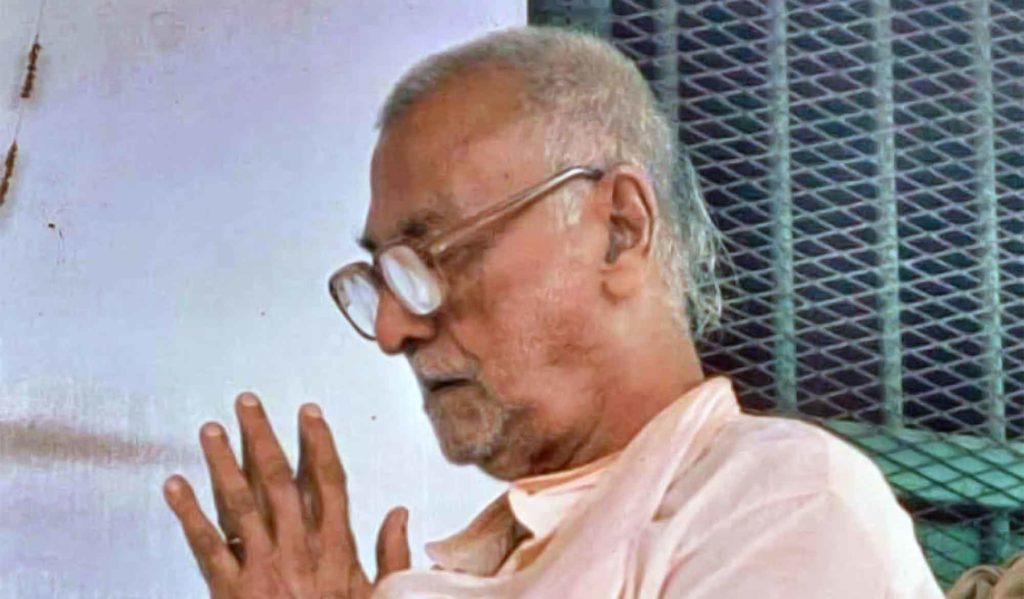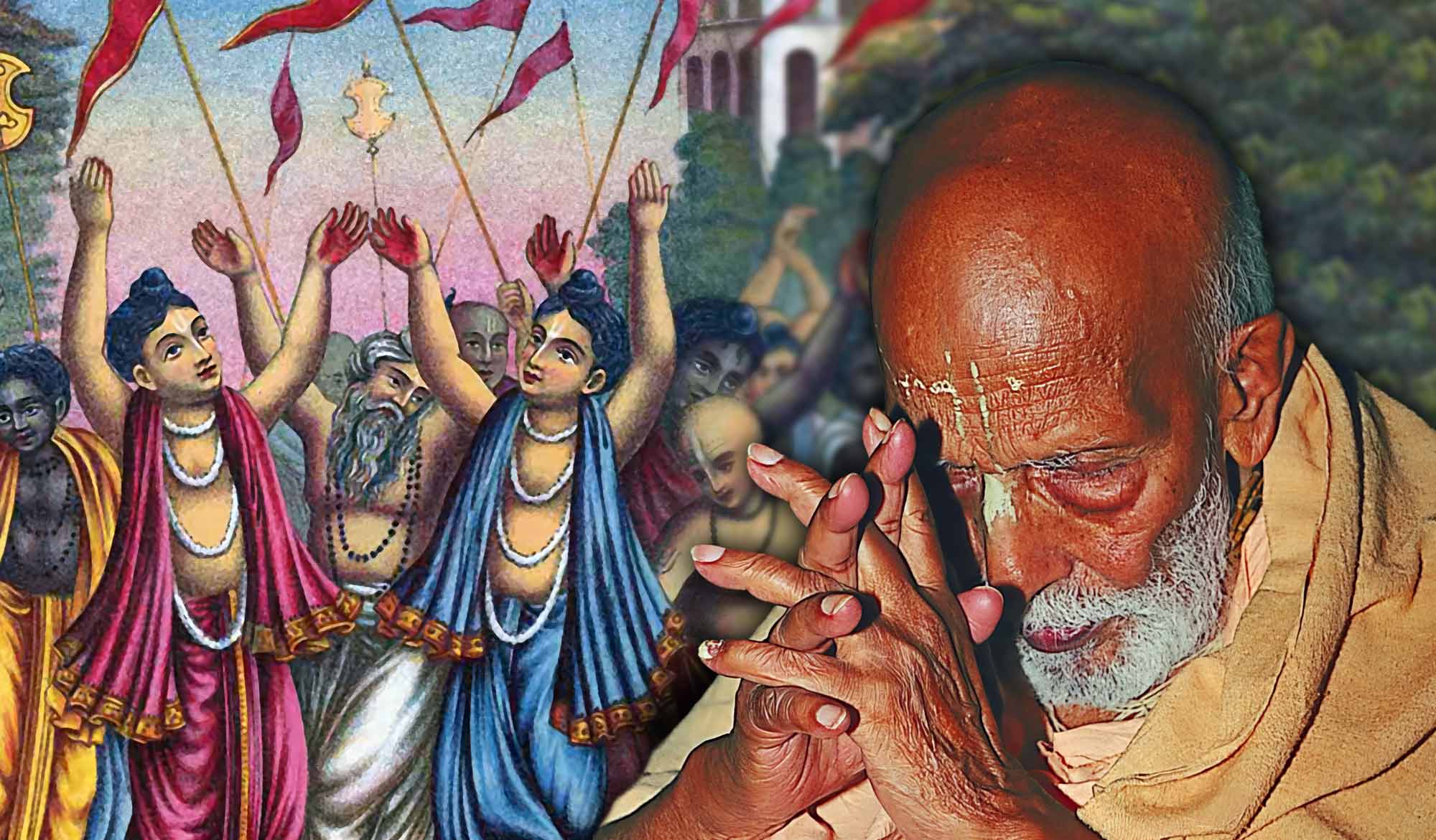Overview
The following is an excerpt from class by Śrīla Narasiṅgha Mahārāja given on 22nd February 2012 in which Mahārāja discusses Bhaktivinoda Ṭhākura's song, 'Jaya Rādhā-Mādhava.'
jaya rādhā-mādhava kuñja-vihārī
gopī-jana-vallabha giri-vara-dhārī
yaśodā-nandana vraja-jana-rañjana
yāmuna-tīra-vana-cārī
This is a song written by Bhaktivinoda Ṭhākura. It is a simple song and the meaning is also simple.
Jaya radha-madhava – Rādhā-Mādhava have Their pastimes, Their līlā, in the forest of Vṛndāvana. Some time ago you were all in Vṛndāvana, but you may not have noticed much forest there – especially where we are in Rādhā-Dāmodara Temple, there is no forest. But in the time of Kṛṣṇa there were no temples and it was all forest. Vṛndāvana is a type of a playground for Kṛṣṇa, both in daytime and at night. During the day He would come there with the cows, He didn’t live there. Kṛṣṇa didn’t live in Vṛndāvana, He lived in Nandagrāma and Rādhārāṇī lived in another village a few kilometres away called Varṣāṇā. Sometimes we say that Kṛṣṇa was born in Vṛndāvana, but He wasn’t born in Vṛndāvana. Neither was He born in Nandagrāma. He was born in a village called Gokula. After He was one and a half or two years old, Nanda and the cowherd men moved to Nandagrāma. On the way they passed through what we call Vṛndāvana – there was a big forest, the river Yāmuna and there were many pasturing grounds for the cows, so Kṛṣṇa’s father thought, “Oh, this is good place to bring cows for grazing.” But, when you go to Nandagrāma you’ll find that it is on the hill. They chose the hill for safety purposes. In the ancient world a lot of people built towns on a hill, because they could see what was coming – so it was for safety. In Gokula, Kaṁsa sent many demons to kill Kṛṣṇa when He was a baby. Gokula is flat – there are no hills; so, they decided to move and they picked a place which would provide more safety for Kṛṣṇa. In Vṛndāvana when Kṛṣṇa he was a baby and he killed demons, everybody thought, “Oh, the demigods did it. The demigods are protecting Kṛṣṇa.” So, that’s how they came to Gokula. So Vṛndāvana is a place of līlā – it is not where Kṛṣṇa lived.
Kuñja-vihārī – this means Kṛṣṇa likes to wander in the groves in the forests of Vraja.
Gopī-jana-vallabha – this means, the one who attracts and has loving pastimes with His beloved gopīs.
Giri-vara dhārī – Kṛṣṇa who lifts Govardhana Hill. Which hand did He use to lift Govardhana Hill? He used His left hand. Of the two hands, the right hand is usually considered to be stronger, unless you are ambidextrous. Although the right arm is generally stronger, Kṛṣṇa showed that He could lift Govardhana Hill with his left hand. Actually Kṛṣṇa has no strong arm or weak arm – he can lift Govardhana Hill with either.
Yaśodā-nandana – he is the son of Yaśodā and Nanda Mahārāja, But Vasudeva and Devakī are also His parents. Kṛṣṇa was born in Mathurā, but that Kṛṣṇa is an avatāra of Kṛṣṇa. Kṛṣṇa Himself appears in Gokula, and in Gokula He is the son of Yaśodā and Nanda. In Mathura He is the son of Vasudeva and Devakī. If you go to Mathurā today, there is a temple where you can go and you can touch that actual spot where Kṛṣṇa appeared. Previously that was the dungeon of Kaṁsa and Vasudeva and Devakī were in that prison when Kṛṣṇa appeared. It is sometimes said that Yaśodā and Nanda were the foster-parents of Kṛṣṇa and not His real parents, because in the Bhāgavatam it simply says that Vasudeva and Devakī are His mother and father. But there are many complicated details and when we go through all of them we find that there were two Kṛṣṇas appearing at the same time – one is Kṛṣṇa original form and another one is a duplicate.
Vraja-jana-rañjana – vraja-jana means the people of Vṛndāvana and rañjana means that He gives great happiness to them. Vraja means Mathurā, Govardhana, Nandagrāma, Varṣāṇā – all the different places there in Vraja-maṇḍala.
Yāmuna-tīra-vana-cārī – Kṛṣṇa is always playing in the forest. Vana means the forest. He is always playing in the forest on the banks of Yāmuna.
There are many names of Kṛṣṇa. The principle name is Kṛṣṇa, but because He has many cows he is called Govinda; because He gives liberation He is called Mukunda. In ancient times if a kings won a battle against the Assyrians, the king would be given some title such as, ‘conqueror of the Assyrians.’ So, according to Kṛṣṇa’s different līlās He has thousands of names, not just hundreds, thousands.
Glorifying the name of God is the dharma for Kali-yuga. Of all the names of the Lord, the name of Kṛṣṇa is considered to be the principle one. But, while chanting the Mahā-mantra we don’t just chant, ‘Kṛṣṇa, Kṛṣṇa, Kṛṣṇa.’ There is also Rāma and Hare. ‘Hare’ means Rādhārāṇī. When we chant the Mahā-mantra we are chanting the names of Rādhā and Kṛṣṇa. ‘Rāma’ also means Kṛṣṇa, the lover of Rādhārāṇī. Rāma can sometimes mean Balarama if you say ‘Rāma’ by itself. But when you chant, ‘Hare Rāma’ that ‘Rāma’ becomes the name of Kṛṣṇa because ‘Hare; is Rādhārāṇī. Therefore the Maha-mantra contains the names of Rādhā and Kṛṣṇa. But if you are in India and you chant the Maha-mantra, when you say, ‘Hare Kṛṣṇa,’ common people will think of Kṛṣṇa playing a flute, but when you say ‘Hare Rāma’ they think of Rāmacandra with His bow. They think completely different.
When Prabhupāda would meet such people in India, they would say, “Rāma means Rāmacandra” and Prabhupāda would say, “Yes, it means Rāmacandra – please chant Hare Kṛṣṇa Hare Rāma.” And if Prabhupāda met a Muslim who said that, “Allah is the name of God!” Prabhupāda would say, “Then you chant the name of Allah – chant the name of God. That is the religion for Kali-yuga.” Some people would say, “Jesus is the name of God,” others would say, “Yahweh is the name of God” and Prabhupāda would say, “Then you chant the name of God!” But then he would laugh and say, “But no one is doing it. They are only arguing because we are doing it.”
We are chanting the name of Kṛṣṇa – then they want to argue that, “Jesus is also a name of God,” “Allah is also a name of God.” But Kṛṣṇa is not just limited to one name! If someone claims that Allah is God, Jesus is God or even Kṛṣṇa is God, then who are we actually talking about? What does ‘God’ mean? Firstly, everybody says that God is the creator – we agree. But what else does God do besides create?
The next thing everybody will say is that, “He provides our food?” We also agree. So we have got all these Gods and they all do the same thing. They all create, they all provide, but what else do they do? The other thing these Gods do is that they punish people. God punishes the wrongdoers and He punishes those that don’t believe in Him forever. At this point we say, “No! Not Kṛṣṇa.” If we then ask them, “What else does God do besides create, provide food and punish?” it starts to become very thin – because He doesn’t do anything else. But we can continue to answer that God, or Kṛṣṇa, is all merciful, He is the supreme enjoyer, He is enjoying pastimes of love with His devotees and there are many other things that Kṛṣṇa does.
Kṛṣṇa does not punish people forever in any kind of hell. If any God does that then He is not God – He is a demon. This is analysis, and by such a simple analysis we can conclude that Kṛṣṇa is the Supreme Being. Others may say, “God is Allah” or “God is Jesus,” and we may say, “Okay, that’s good. You chant their name and sing their glories.” But in reality that will be very, very limited.
Once we enter into Kṛṣṇa consciousness that is our main concern. We are not concerned in criticizing others, but at the same time we should know that it is not all the same – there are differences. We should understand this and focus on what is Kṛṣṇa consciousness.
Related Articles, Songs and Prayers
- Śrī Gaura-hari Kusuma Stavāṣṭākam by Śrīla Bhakti Rakṣaka Śrīdhara Deva Gosvāmī
- Śrī Kusumañjalī (An Offering of Flowers) by Śrīla Bhakti Rakṣaka Śrīdhara Deva Gosvāmī
- Śrī Nāma Māhātmya (The Glories of the Holy Name) by Śrīla Bhakti Rakṣaka Śrīdhara Deva Gosvāmī
- Śrī Nityānanda Dvādaśakam by Śrīla Bhakti Rakṣaka Śrīdhara Deva Gosvāmī
- Śrīmad Bhaktivinoda Viraha Daśakam by Śrīla Bhakti Rakṣaka Śrīdhara Deva Gosvāmī
- Śrī Śrī Gaurasundara Āvirbhava Vāsare by Śrīla Bhakti Rakṣaka Śrīdhara Deva Gosvāmī
- ‘The Best of Thieves’ – An Illumination by Śrīla Bhakti Rakṣaka Śrīdhara Deva Gosvāmī
- Mā Muñca Pañca-daśakam (Fifteen Verses Praying Not to be Abandoned) by Śrīla Śrīdhara Deva Gosvāmī Mahārāja
- Śrīla Sarasvatī Gosvāmyāṣṭakam by Śrīla Śrīdhara Deva Gosvāmī Mahārāja
- Vṛndāvane Bhajana (Worship in Vṛndāvana) by Śrīla A.C. Bhaktivedānta Swami Prabhupāda
- Vaiśiṣṭyāṣṭaka (Eight Stanzas of Significance) by Śrīla A.C. Bhaktivedānta Swami Prabhupāda
- Svasti No Gaura-vidhur Dadhātu (May the Moon-like Gaura Bestow Auspiciousness) by Śrīla B.P. Purī Mahārāja
- A Prayer Composed on the Occasion of the Disappearance of Śrīla Gadādhara Paṇḍita by Śrīla Bhakti Pramoda Purī Gosvāmī
- Śrī Śrī Gaura Gopāla Praśasti (In Praise of Śrī Śrī Gaura Gopāla) by Śrīla Bhakti Pramoda Purī Gosvāmī
- Viraha-Gītikā (A Song of Separation) by Śrīla Bhakti Pramoda Purī Mahārāja
- Jaya Rādhā-Mādhava by Śrīla Bhakti Gaurava Narasiṅgha Mahārāja
- Purport to Śrīla Prabhupāda-līlā Smaraṇa-Maṅgala Stotram by Śrīla Bhakti Gaurava Narasiṅgha Mahārāja
- Purī Mahārāja’s Praṇāma Mantra by Śrīla Bhakti Gaurava Narasiṅgha Mahārāja
- Śrī Guru-viraha Ṣaṭakam – Six Verses in Separation from Śrī Guru by Swami B.V. Giri
- Śrī Guru Praṇāma Anuvākya – An Explanation of Śrīla Guru Mahārāja’s Praṇāma Mantra by Swami B.V. Giri
Further Reading from the Bhaktivinoda Institute
- Gītā-mālā (A Garland of Songs) by Śrīla Bhaktivinoda Ṭhākura (Songbook)
- Kalyāṇa Kalpataru (‘The auspicious Desire Tree’) by Śrīla Bhaktivinoda Ṭhākura (Songbook)
- Śaraṇāgati (Surrendered to the Lord’s Shelter) by Śrīla Bhaktivinoda Ṭhākura (Songbook)
- Gītāvalī (A Collection of Songs) by Śrīla Bhaktivinoda Ṭhākura (Songbook)
- Bāula Saṅgīta by Śrīla Bhaktivinoda Ṭhākura (Songbook)
- Sevā Lālasā (Hankering for Service) by Śrīla Bhaktivinoda Ṭhākura (Songbook)
- Śrī Godruma-candra Bhajanopadeśa by Śrīla Bhaktivinoda Ṭhākura
- Śrī Kṛṣṇacandra by Śrīla Bhaktivinoda Ṭhākura
- Śrī Gīta Govinda Introduction by Śrīla Bhaktivinoda Ṭhākura
- Poems by Śrīla Bhaktivinoda Ṭhākura
Prabhupāda Śrīla Sarasvatī Ṭhākura’s Visit to Ayodhyā
With the forthcoming observance of Śrī Rāma Navamī, we present 'Prabhupāda Śrīla Sarasvatī Ṭhākura’s Visit to Ayodhyā' written by Śrīla Bhaktisiddhānta Sarasvatī Ṭhākura Prabhupāda from The Gaudīyā magazine, Vol 3. Issue 21/ In December 1924, after visiting Benares and Prāyāga, Sarasvatī Ṭhākura visited the birth-site of Śrī Rāmācandra in Ayodhyā.
Śaraṇāgati – The Only Path to Auspiciousness
In this article, 'Śaraṇāgati - The Only Path to Auspiciousness', Dhīra Lalitā Dāsī analyses the process of śaraṇāgati (surrender) beginning with śraddhā (faith). She also discusses the role of śāstra and the Vaiṣṇava in connection with surrender.
Ātma Samīkṣā – The Value of Introspection
In this article, "Ātma Samīkṣā – The Value of Introspection" Kalki Dāsa highlights the importance of introspection in the life of a devotee and especially in relation to the worldly environment that surrounds us. He also explains how transcendental sound influences our capacity to introspect.
Svasti No Gaura-vidhur Dadhātu (May the Moon-like Gaura Bestow Auspiciousness)
This Bengali poem, ‘Svasti No Gaura-vidhur Dadhātu,’ (May the Moon-like Gaura Bestow Auspiciousness) written by Śrīla Bhakti Pramoda Purī Gosvāmī, was first published in 1965 in Caitanya Vāṇī magazine, Vol.5, Issue 1. In this composition, Śrīla Purī Mahārāja gives advice to the fallen jīvas to sincerely accept Mahāprabhu's gift of the Holy Name. This poem was translated into English by Sanātana Dāsa and Parameśvarī Devī Dāsī.
Prabhupāda Śrīla Sarasvatī Ṭhākura’s Visit to Ayodhyā
With the forthcoming observance of Śrī Rāma Navamī, we present 'Prabhupāda Śrīla Sarasvatī Ṭhākura’s Visit to Ayodhyā' written by Śrīla Bhaktisiddhānta Sarasvatī Ṭhākura Prabhupāda from The Gaudīyā magazine, Vol 3. Issue 21/ In December 1924, after visiting Benares and Prāyāga, Sarasvatī Ṭhākura visited the birth-site of Śrī Rāmācandra in Ayodhyā.
Śaraṇāgati – The Only Path to Auspiciousness
In this article, 'Śaraṇāgati - The Only Path to Auspiciousness', Dhīra Lalitā Dāsī analyses the process of śaraṇāgati (surrender) beginning with śraddhā (faith). She also discusses the role of śāstra and the Vaiṣṇava in connection with surrender.
Ātma Samīkṣā – The Value of Introspection
In this article, "Ātma Samīkṣā – The Value of Introspection" Kalki Dāsa highlights the importance of introspection in the life of a devotee and especially in relation to the worldly environment that surrounds us. He also explains how transcendental sound influences our capacity to introspect.
Svasti No Gaura-vidhur Dadhātu (May the Moon-like Gaura Bestow Auspiciousness)
This Bengali poem, ‘Svasti No Gaura-vidhur Dadhātu,’ (May the Moon-like Gaura Bestow Auspiciousness) written by Śrīla Bhakti Pramoda Purī Gosvāmī, was first published in 1965 in Caitanya Vāṇī magazine, Vol.5, Issue 1. In this composition, Śrīla Purī Mahārāja gives advice to the fallen jīvas to sincerely accept Mahāprabhu's gift of the Holy Name. This poem was translated into English by Sanātana Dāsa and Parameśvarī Devī Dāsī.








